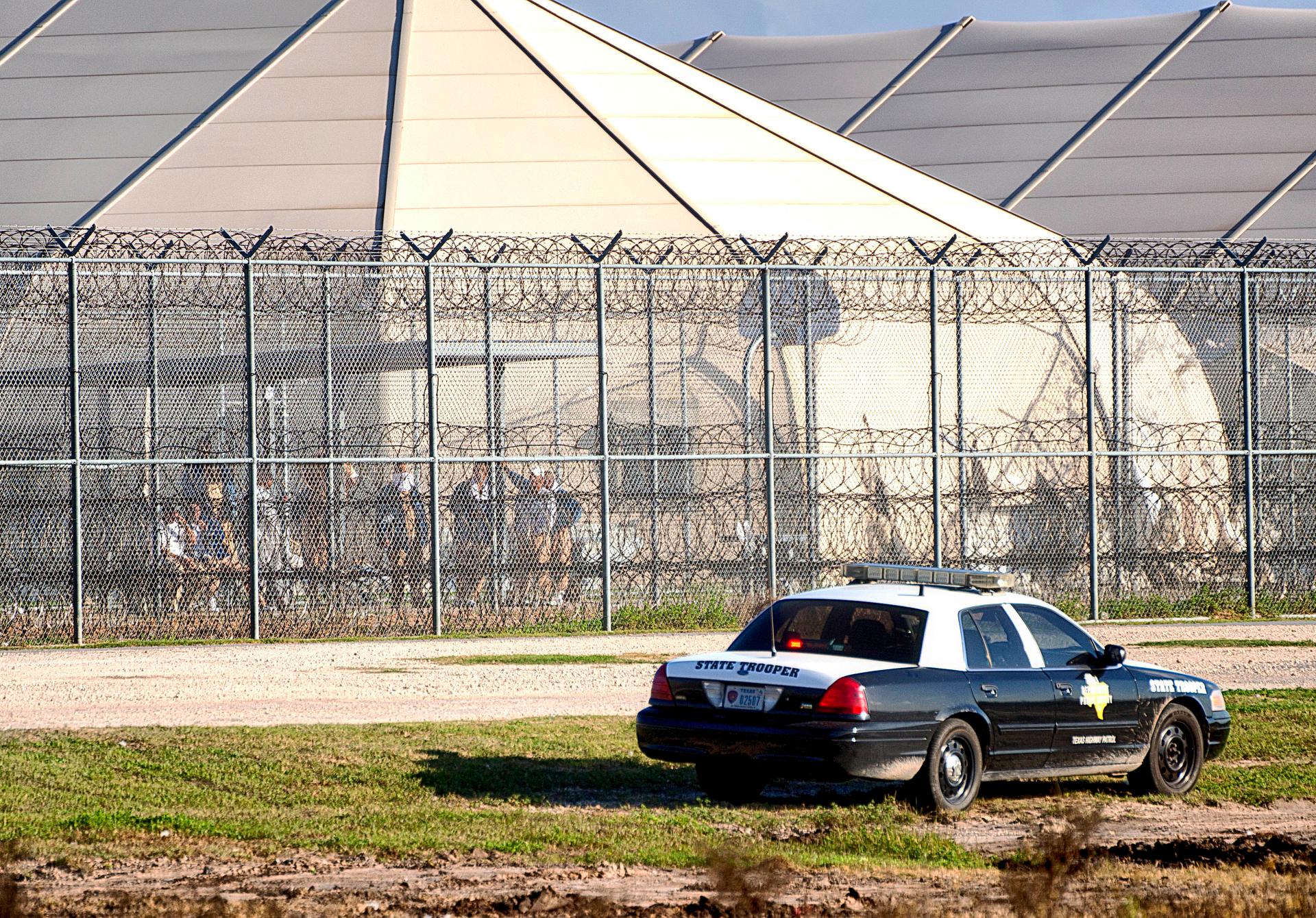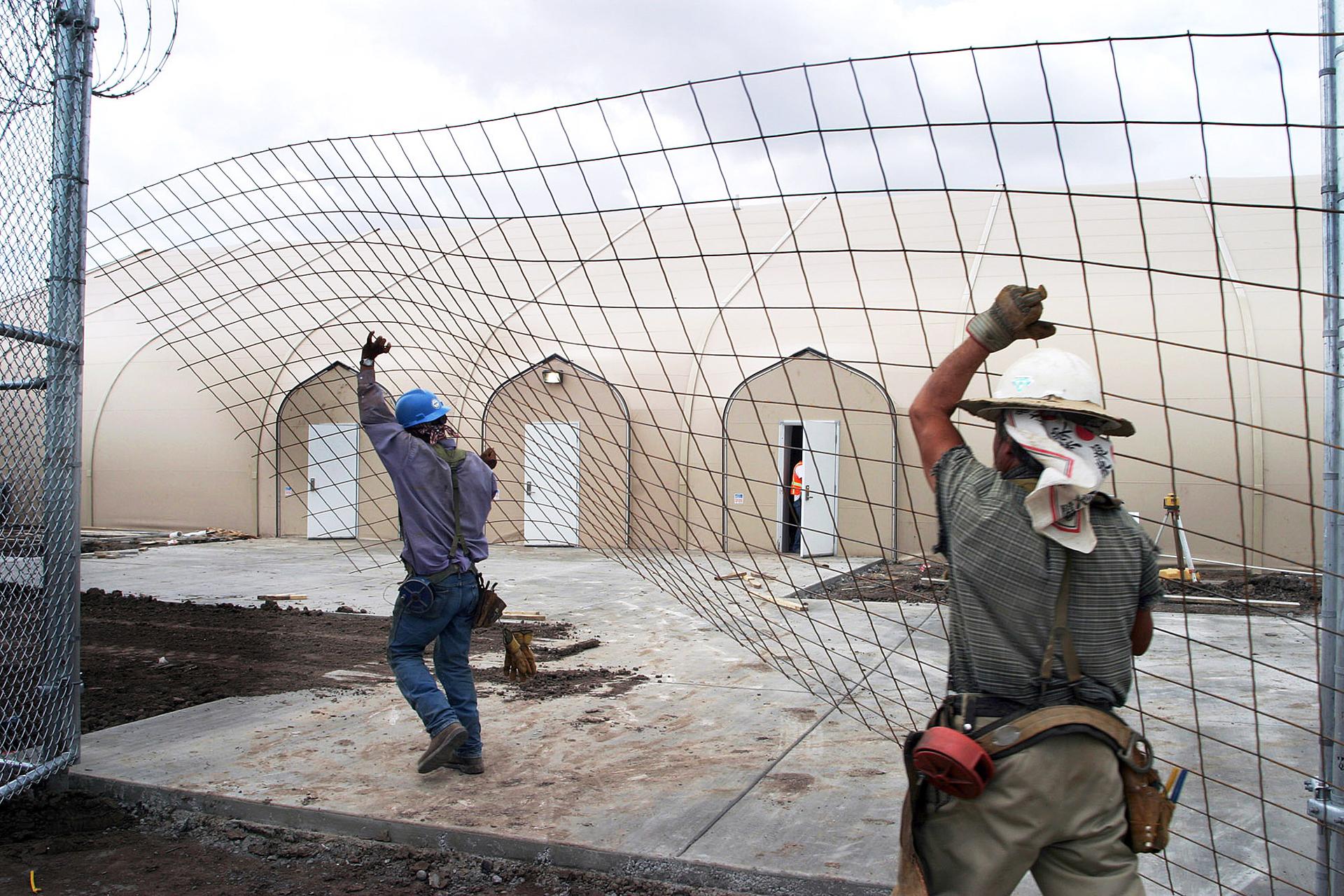A private prison company with a troubled past looks to reopen an immigration detention facility in Texas
Workers carry wire mesh past the first tent-like dome erected at the privately operated prison in Raymondville, Texas, on Thursday, July 27, 2006. By the time the facility closed after a riot in 2015, it housed 2,700 immigrant prisoners.
The private prison company, Management and Training Corporation, uses the slogan “B.I.O.N.I.C.” on its website and job listings. It stands for: “Believe it or not, I care.”
But inmates housed at one of MTC’s facilities in Raymondville, Texas, in the Rio Grande Valley didn’t buy the private prison company’s slogan. In 2015, a protest at the Willacy County Correctional Center turned into a riot. The fighting left the facility uninhabitable and it was shut down.
MTC isn’t alone among private prison companies in its safety problems.
A review by the Department of Justice inspector general released last August showed that private prisons, which hold 12 percent of about 200,000 federal inmates, have more “safety and security incidents per capita” than those operated by the Federal Bureau of Prisons.
At the time, Willacy housed almost 2,700 immigrant prisoners, but it was not an immigration detention center. Rather, it housed male inmates who were going to be deported at the end of their criminal sentences. MTC responded to the inspector general review that their unique prison population — “criminal aliens,” mostly from Mexico — was not accounted for in the report.
But privately run immigration detention facilities, with oversight from the Department of Homeland Security, have also been plagued by complaints about conditions and safety. About 72 percent of more than 325,000 immigrant detainees were held in facilities run by many of the same private prison companies that run federal prisons, according to 2015 data obtained by TRAC, the Transactional Records Access Clearinghouse at Syracuse University.
The justice department announced last summer that it would end its use of privately-run prisons by allowing contracts to end over five years. The DHS conducted a review of their agreements with these companies, but said they would not do the same.
Trump’s Department of Justice has announced it will resume contracting with private prison companies. Attorney General Jeff Sessions said in a one-paragraph memo reversing the Obama-era decision that ending those contracts “impaired the Bureau’s ability to meet the future needs of the federal correctional system.”
In the first months of the Trump administration, the number of immigrants arrested and detained by the immigration agency has increased. One of Donald Trump’s executive orders signed on January 25 called on the DHS to “allocate all legally available resources to immediately construct, operate, control, or establish contracts to construct, operate, or control facilities to detain aliens at or near the land border with Mexico.”
So, almost two years after the Willacy County Correctional Center was closed, MTC is looking to reopen it again — this time as an immigration detention facility near the border. They are currently in talks with Immigration and Customs Enforcement, the immigration agency within DHS.

Carl Takei is a staff attorney at the National Prison Project at the American Civil Liberties Union. He says he would not be surprised if MTC and ICE finalize a contract, despite their troubled history together.
“In 2006, it opened-up as an immigration detention facility and it earned the nickname of ‘Ritmo’ — the Gitmo of Raymondville — because of reports of widespread sexual abuse, overcrowding, vermin infestations and unsanitary conditions,” says Takei. “Ritmo was a tent city prison, meaning it was made-up of row after row of 200-foot-long kevlar tents behind barbed wire fences.”
Both men and women who were either facing deportation, received final orders for removal from the US, or were actively fighting their cases to remain in the country, were housed at the Willacy Detention Facility from 2006 to 2011.
After problems came to light, ICE decided not to extend its contract with MTC.
About a month later, the facility reopened under contract with the Federal Bureau of Prisons as a “criminal alien requirement prison,” a contract it maintained from 2011 to 2015. These types of prisons hold people who are serving sentences for federal crimes, but are not US citizens.
Takei says these kinds of contracts created “a separate, segregated system of shadow private prisons” without the types of rehabilitation services and programs found at regular federal prisons.
“The Bureau of Prisons felt that it could send people who are not US citizens to private prisons because it could assume they wouldn’t return to US communities,” he says. “It didn’t particularly matter if the private prisons failed to rehabilitate them.”
Most of the people detained at the Willacy County prison during those years were convicted of drug offenses or for illegally entering the US after being deported at least once. Takei says people convicted of illegal reentry serve sentences of anywhere between two and 20 years.
In 2014, the American Civil Liberties Union published a report about the alleged offenses at the Willacy County facility, both as an immigration detention facility and as a prison.
“We heard many of the same complaints that had plagued Willacy in its incarnation as an immigration detention center,” says Takei. “Overcrowding, toilets that constantly overflowed, insects crawling into the tents, solitary confinement cells being used as overflow space and inadequate medical treatment. People even said there was a feeling of anger and frustration throughout the prison.”
The next year was the riot. Some say the prisoners were protesting the conditions and lack of medical care at the facility, but others says it was actually prison staff who caused the riot. In August 2016, the Department of Justice’s Office of the Inspector General issued a report that the Willacy County corrections center was uninhabitable.
A question for President Trump: How will you handle cases of abuse at privately run prisons and immigration detention centers?
A few months later, Willacy County officials filed a lawsuit against MTC and blamed the private prison company for the riot. The lawsuit cites MTC’s “abysmal management of the prison.”
“MTC allowed the abysmal conditions to continue without taking any action or notifying the County of or attempting to rectify the problems with the Prison,” says the complaint. “Further, MTC failed to address the issue of prison overcrowding, presumably because MTC was paid an additional per diem for inmates beyond the 90 percent capacity threshold.”

The county suffered a major economic loss after the prison closed in 2015. Aurelio Guerra is a Willacy County judge and sits on the county’s five-person Commissioners Court (Texas calls its elected county leaders judges — though it’s not a traditional judicial role). He says they relied heavily on the income the MTC facility brought in.
“That particular facility generated about $2.4 million a year for the county,” says Guerra. “Unfortunately, a big percent of those monies were used for the general fund to run the county.”
Some of the money collected by Willacy County came from the federal government. The county collected a fee for every inmate in the prison. And part of that money went to paying off the debt on the facility and its operating costs.
Since the closure of the prison, Willacy County has cut its budget from $8.1 million to $6.9 million. Guerra says the county’s office had to cut about 24 jobs, plus all 400 jobs at the facility were lost.
According to the US Census Bureau, Willacy County is home to about 21,000 people — about 35 percent live in poverty. The closure of the Willacy Correctional Center made it even more difficult to find work in the county. The county was about $68 million in debt after the facility’s closure in 2015.
Raymondville City Manager Eleazar Garcia Jr. says the county made its deal with MTC using a County Public Facilities Corporation, a separate quasi-governmental agency that allows them to issue bonds for major projects, like building the facility.
There was a $60 million bond issued for the first prison, then the facility had an expansion, requiring more debt — a little more than $60 million, says Garcia.
Garcia says when the county ended its contract with ICE and the facility became a federal prison in 2011, a retrofit was needed. So the corporation sold more bonds, increasing its debt to about $100 million.
That debt is one of the reasons why, Guerra says, the commissioners sued MTC, “to have somebody accountable for us not having that facility operating.”
The commissioners agreed to drop the lawsuit on March 7, 2017, at a commissioner’s court meeting, if MTC purchased the facility outright. The county paid off almost all of the outstanding bonds with the revenue.
The county says it is now in full support of an MTC contract with ICE, or another governmental partner, despite its lawsuit charging that the company mismanaged the prison.
Guerra says it’s not up to the county to determine if MTC qualifies to operate facilities in the area. That, he says, is the role of the federal government.
Willacy County learned some lessons from the first time it disentangled itself from the private prison industry.
Since the closure of the facility, the county has had to find other ways to bring money to the area. Garcia says about six years ago officials brought several wind turbine projects to the area.
There are about 400 turbines in the eastern part of the county, 150 are currently being worked on and another 100 may come to the area.
These projects bring in construction jobs initially, but the county also benefits because the county can tax the windmills and gain some revenue.
Willacy County has also created a three-year plan to navigate and reassess the way they allocate the budget moving forward. Guerra is also looking to the possibility of a liquified natural gas pipeline that will run-through the county.
Guerra says officials now understand the importance of having a diversified economy, so the county is not reliant on prisons. But the hunt for other opportunities isn’t easy — and immigration detention is one option right in front of them.
“Would I rather have a big manufacturer having 500 to 1,000 jobs here?” asks Guerra. “Yes, but that is not on the table and so this is basically what we have. And I’ll listen to the constituents that have me here as county judge. It seems to me that there is no opposition, at least here locally.”
There is no contract between ICE and MTC yet, so Guerra does not yet know what role the county might play. But he does know the facility will be on the county’s tax roll, so they’ll be able to tax the facility and gain some additional revenue.
And if the Willacy facility reopens, there will be some changes. Instead of holding 3,000 inmates, it will be downscaled to about 1,000. Also, the tent-like kevlar structures will be dismantled.
Also: Here’s how private prisons are being challenged, even as they scale up
Issa Arnita is the communications director for MTC, which is headquartered in Utah. He says they’re constantly looking for ways to make all of their facilities more safe and secure to prevent previous issues from recurring.
“We’ve been operating prisons for federal governments and state governments for more than 30 years, and while there have been some incidents, our record is good and clean and solid,” says Arnita. “Those who work with us understand that, including the county.”
The county’s lawsuit, with its allegations of severe mismanagement, is water under the bridge.
“I think sometimes you say things you don’t really mean in the heat of the moment, or when you’re under a lot of pressure, and I believe that’s what happened,” says Arnita.
As for the ACLU’s 2014 account of abuses and health care issues, Arnita says it was “agenda-driven.”
“They’ll go in there with an agenda and talk to certain individuals in the facility,” he says. “We allow them to come in the facility, they talk and they get what they want to hear and then they develop a report based on that.”
“In terms of performance, we’re monitored by our government partner every single day. They see what we do, they see how we treat the offenders, they see the medical care that we give them, they understand the programming we provide for them and the services. They know that we’re a quality company.”
But Takei at the ACLU says government oversight is inadequate because there is no third-party review of immigration detention centers or federal prisons. The Bureau of Prisons and ICE have an internal system of private prison oversight to identify problems and monitor their facilities.
“ICE routinely conducts annual inspections that use a checklist form to decide whether the facility is sufficiently complying with ICE detention standard,” says Takei. “In addition to those annual inspections, sometimes, but not every year, a facility may be visited by the office of detention oversight, which was created by the Obama administration.”
The Office of Detention Oversight conducts a more in-depth investigation of conditions at facilities. They review medical records and examine the practices of a facility. In 2016, the Department of Homeland Security’s Office of Inspector General began its own program of detention facility inspections.
Takei says even though these internal inspections exist, there are still problems with oversight. The Willacy facility, he says, should not be reopened and operated by MTC.
Arnita says MTC’s primary objective, after safety and security, is to provide effective programming to offenders and detainees, so that when they are released they are less likely to reoffend. It operates 22 correctional facilities, many of which are in Texas.
“We’ve got everything in place to make sure that our facilities are safe, but it’s important to understand inmates, or detainees, at times will attempt to cause problems,” says Arnita. “That happens at public facilities, it happens at private facilities. It happens everywhere, but when you’re looking for incidents and you base an entire company’s reputation on an incident, that’s disingenuous.”
If ICE does contract with MTC to reopen the Willacy County facility, immigrant detainees will not be brought in right away. Arnita says it will take several months to make repairs to the damaged structure. After several months of negotiating with ICE to secure a contract, no official agreement has been made.
Find more documents related to this story here. With additional reporting by Angilee Shah.
